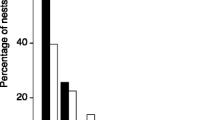Abstract.
I studied the behavioural profiles of fourteen species of Chilean halictine bee using the circle tube apparatus. Interactions were classified as aggressive, avoidance or cooperative. One species, Corynura chloris, is believed to be semisocial and its behaviour was largely aggressive, Ruizantheda mutabilis is known to be communal and its behaviour was predominantly cooperative whereas Penapis toroi is a member of a subfamily from which only solitary behaviour is known and it primarily exhibited avoidance behaviours. As a result, I suggest that the relative frequency of these different behaviours may be useful in establishing the social organisation of species. Based upon comparisons of behavioural profiles, I predict the social organizations of the remaining species and suggest that at least some of the bees in the populations of Ruizantheda proxima, Caenohalictus dolator, Ca. species A and Pseudagapostemon pississi investigated exhibit communal behaviour; those of Co. patagonica and Co. herbsti likely have a reproductive division of labour, probably within semisocial societies, and that the populations of Co. corinogaster, Co. melanocladius, Ca. pygosinuatum, Ca. cuprellus and Lasioglossum aricense studied are probably solitary. Phylogenies suggest that solitary behaviour in Ca. pygosinuatum and Ca. cuprellus is reversed from communal behaviour and solitary behaviour in L. aricense may be a reversal from eusociality. The response “back and follow” is not indicative of dominance or cooperation as it correlated only with the frequency of avoidance interactions among the taxa studied. I discuss the utility of the circle tube apparatus in the identification of populations worthy of more detailed sociobiological investigation.
Similar content being viewed by others
Author information
Authors and Affiliations
Corresponding author
Additional information
Received 10 August 2005; revised 8 March 2006; accepted 21 March 2006.
Rights and permissions
About this article
Cite this article
Packer, L. Use of artificial arenas to predict the social organisation of halictine bees: Data for fourteen species from Chile. Insect. Soc. 53, 307–315 (2006). https://doi.org/10.1007/s00040-006-0873-x
Published:
Issue Date:
DOI: https://doi.org/10.1007/s00040-006-0873-x




